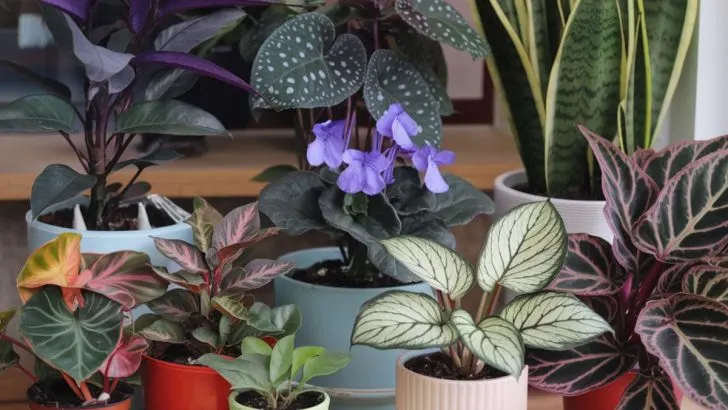If you are tired of green plants in the house, today we will talk about colorful houseplants. Among the 13 colorful plants that we bring you, you will surely be able to find one perfect for you and your home.
These diverse plants will bring beauty and color to your home and you will immediately change that difference.
Some of them are tropical plants and require slightly warmer conditions than those plants you are used to, but I’m sure it’s worth taking care of them.
Some of these plants will look great in a hanging basket, and some you can put on your favorite bookshelf in a pot. Vining plant, arrowhead vine, solid green, dark green with pink, you choose the one that suits you the most.
Let’s Add Colors To Green Leaves

There may not be one perfect plant for your home, but that’s why there are 13 perfect plants for your home and we’re going to introduce them to you today.
Green-red leaves, purple house plants with white pores, white-green leaves, and much more. All of those plants are in this article for you. Let’s see more.
1. Purple Passion Plant
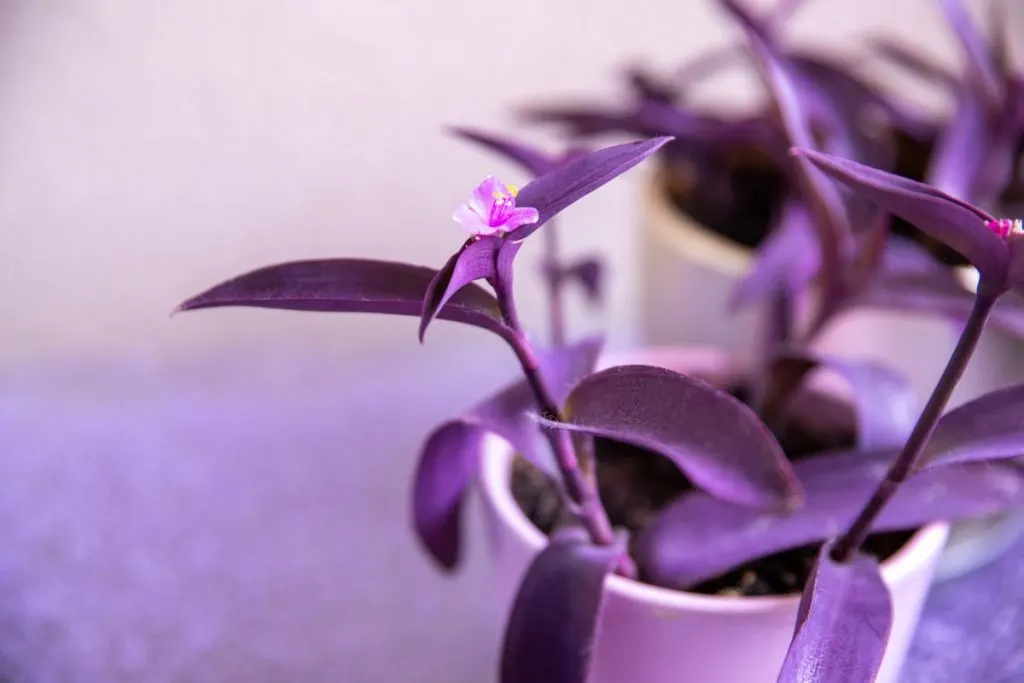
It is related to asters and comes from a very large family of similar plants. This unique variety is native to Indonesia and Java. A similar care guide has an arrowhead plant and a Chinese evergreen plant with its green variegated leaves.
Light Conditions
This plant does best in partial, filtered, or indirect sun. A north-facing window or near a window should provide sufficient light and receive morning sunlight.
Soil Type
This plant needs good drainage to stay healthy. For this, you can put gravel in the bottom of the container. Well-drained potting soil should suffice as a planting medium.
Water Schedule
Regular watering during the active growing season to keep the soil slightly moist will help keep these vines healthy. It is very important not to water the fashionable purple flower. A little gravel in the bottom of the container can help, make sure there is a drain hole.
Temperature And Humidity
Extreme temperatures can damage purple passion flowers, so it’s a good idea to make sure there are no winter drafts on windows that hang near them.
Moisture can be a problem as the velvety hairs on the leaves can trap water and this can usually lead to leaf rot. A humid environment isn’t a firm yes for this plant.
Fertilizer
Purple passionflower benefits from regular fertilization. That is, fertilize with a dilution ratio once every two weeks during the active growing season and once a month in the winter.
Propagation
This plant can be easily propagated from cuttings and is planted in potting soil to keep it moist. It takes about 1 to 2 weeks for roots to form.
2. Polka Dot Plant
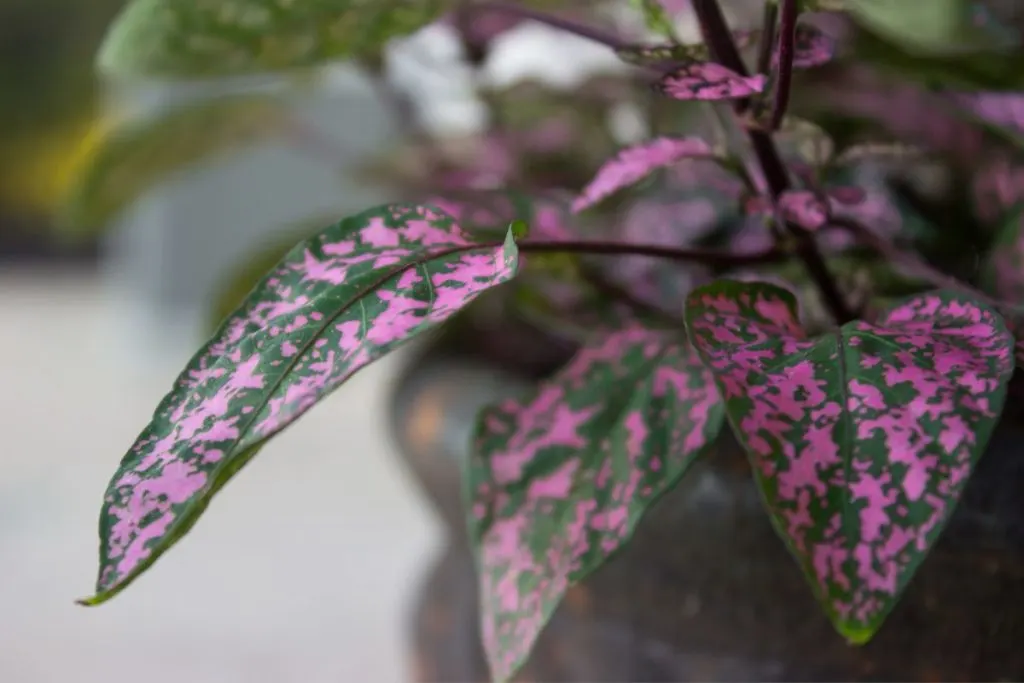
The polka dot plant is an attractive plant with brightly colored leaves that set it apart from most other leaves. The most common polka dot plants have leaves with green spots on a pink background.
Light Conditions
When grown outdoors, polka dot plants like shady spots. Choose a planting spot that doesn’t get too much or too little light. Otherwise, the leaves may lose their color and reduce the decorative value of the plant.
Soil Type
Polka dots prefer soil rich in organic matter that drains well. Organic all-purpose potting mixes are usually suitable for these plants. Mix some pumice or perlite to improve soil drainage.
Water Schedule
This plant always prefers moderate soil moisture. Do not let the soil dry out completely. Then the leaves will wilt and the plant may struggle to survive.
Make sure the soil is not wet. Then the roots can rot and the plant can die. Reduce watering slightly in winter and resume the routine in spring when growth is restored.
Temperature And Humidity
Polka dots are hardy only in USDA growing zone 10 and prefer temperatures above 60F. This plant likes moist conditions and prefers at least 50% humidity.
Fertilizer
Feed container plants with organic fertilizer once a month during the warm growing season. This plant is a heavy feeder.
Propagation
Polkadot plants can be grown from seed or stem cuttings. If starting from seed, sow in early spring. You can comb the cut at any time. However, once you learn how to propagate the polka dot plant it will be more than a routine for you.
3. Prayer Plant
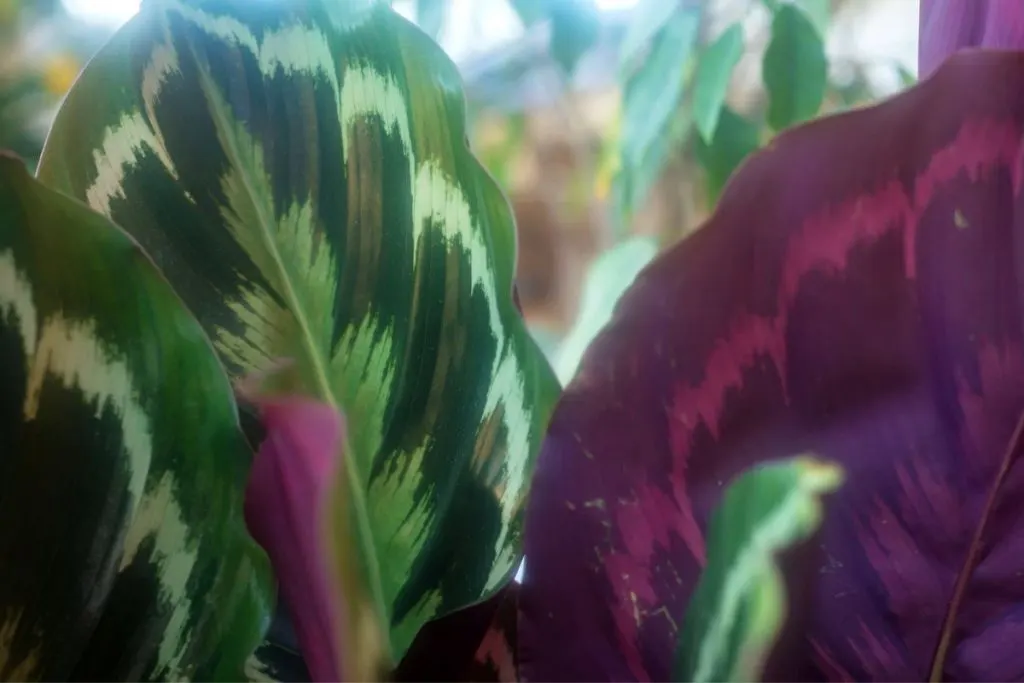
Named after the 16th-century Italian physician and botanist Bartolomeo Maranta, the genus Maranta contains dozens of lowland plants native to Brazil, including prayer-plants.
Light Conditions
Hang or place prayer plants near windows that receive indirect sunlight. Do not place the plant in direct sunlight, better is a bright window in your home. The sun can burn the leaves of the plant, or the leaves can stain or stain and lose their color intensity.
Soil Type
Prayer plants can grow in a variety of soils as long as they have good drainage. Traditional potting soil usually works well, but you can make your own by combining 2 peat moss, 1 clay, and 1 perlite or coarse sand.
Water Schedule
During the growing season, water the plants regularly and make sure that the potting soil does not dry out completely. This plant is very sensitive to drought and will not survive long without water.
However, to avoid mold problems, do not allow water to come into direct contact with the leaves or keep the plant moist.
Temperature And Humidity
Prayer plants prefer a moderate room temperature between 60-80F. Long-term low temperatures can damage the leaves and they may fall from the plant. Prayer plants also thrive in very moist environments.
Fertilizer
Fertilize with a water-soluble houseplant fertilizer diluted in half every two weeks from early spring through fall. If you use too little fertilizer, your plants will grow slowly or not at all.
Propagation
Growing prayer plants is a surprisingly easy way to expand your collection and use larger mother plants. The most common way to propagate prayer plants is by dividing them by transplanting.
4. African Violet Plant
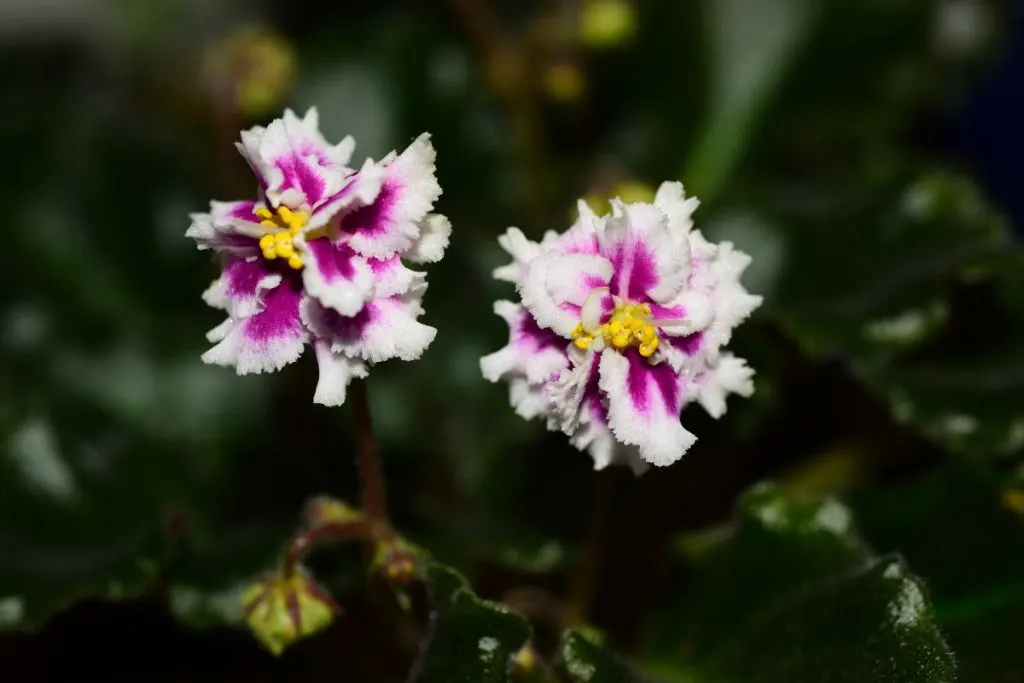
African violets are one of the most popular houseplants in the world and for good reason. This compact, low-growing plant blooms several times a year and comes in a variety of leaf shapes and colors.
Light Conditions
Bright, but no direct sunlight. They usually grow under fluorescent lights 12-15 inches from the leaves.
Soil Type
Well-drained potting soil is essential. Do not leave the plant in standing water for an extended period, as poor drainage can cause the plant to become waterlogged and cause root rot that begins to drop the leaves.
Water Schedule
Keep the soil moist with warm water and watch for high humidity. To avoid damage, keep water off the leaves except for a light mist. When watering, pour water from below or push the faucet into the ground. Do not put the plant in water.
Temperature And Humidity
It did not drop below 60ºF. They thrive at 70°F, below or above they look droopy.
Fertilizer
Fertilize weekly your African violet and then you can be sure it will thrive well and fast.
Propagation
African violets can be propagated from leaves or offsets. Mature plants sometimes produce small plants or side shoots. Get rid of them and follow yourself. Removing it will promote better flowering in the parent plant.
5. Snake Plant
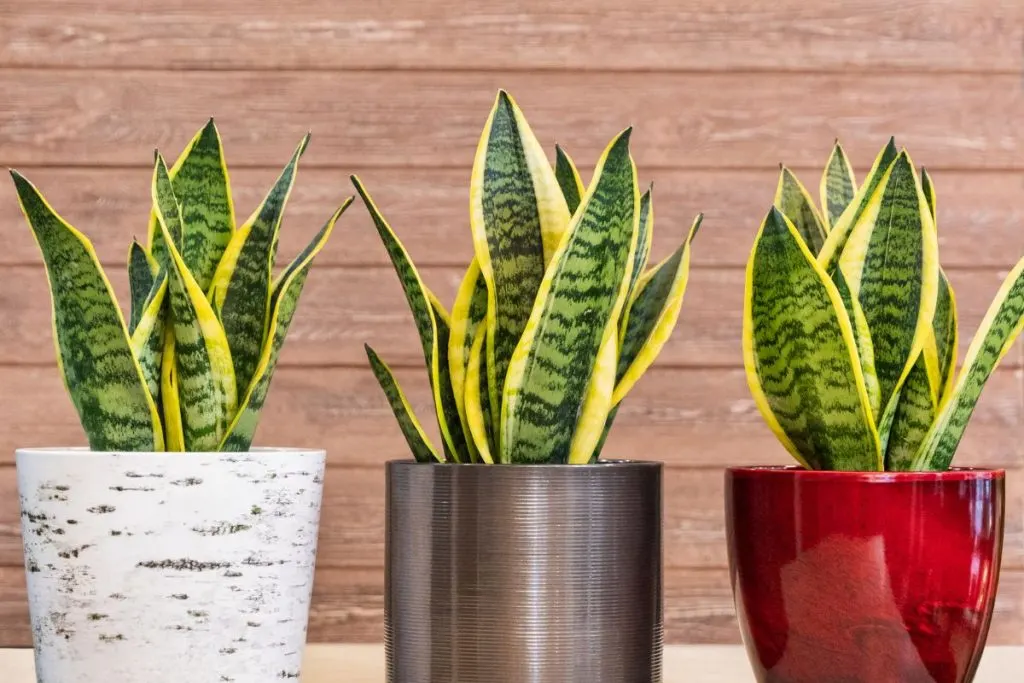
The plant has stiff, sword-shaped leaves and ranges from 6 inches to 8 feet tall. Snake plants can vary in color, but most have green striped leaves and usually have a yellow border. Also, you can always buy a snake plant as the perfect plant for beginners.
Light Conditions
Snake plants prefer constant light with indirect but direct sunlight. They can adapt to the full sun and survive in low-light conditions.
Soil Type
Snake plants prefer loose, well-drained soil. This plant grows well on sandy soils. Use a growing medium with a low peat content. Grass works well in most situations, but can be densely packed and sometimes has rehydration or drainage problems.
Water Schedule
Allow the soil to dry out between waterings. In winter, reduce watering monthly or when the soil is dry. underwater bug; Too much water can harm plants.
Temperature And Humidity
Snake plants love warm conditions and will suffer if exposed to temperatures below 50F. Place the plant in a place that protects it from drafts. A temperature range of 70-90F is best.
Fertilizer
During the growing season, apply light cactus fertilizer or a balanced 20-20-20 liquid fertilizer diluted to half strength.
Propagation
It is best to breed during the growing season, spring or summer. Dracaena plants are easy to divide when transplanting if they are over 4 inches tall. Alternatively, new shoots may appear.
6. Nerve Plant
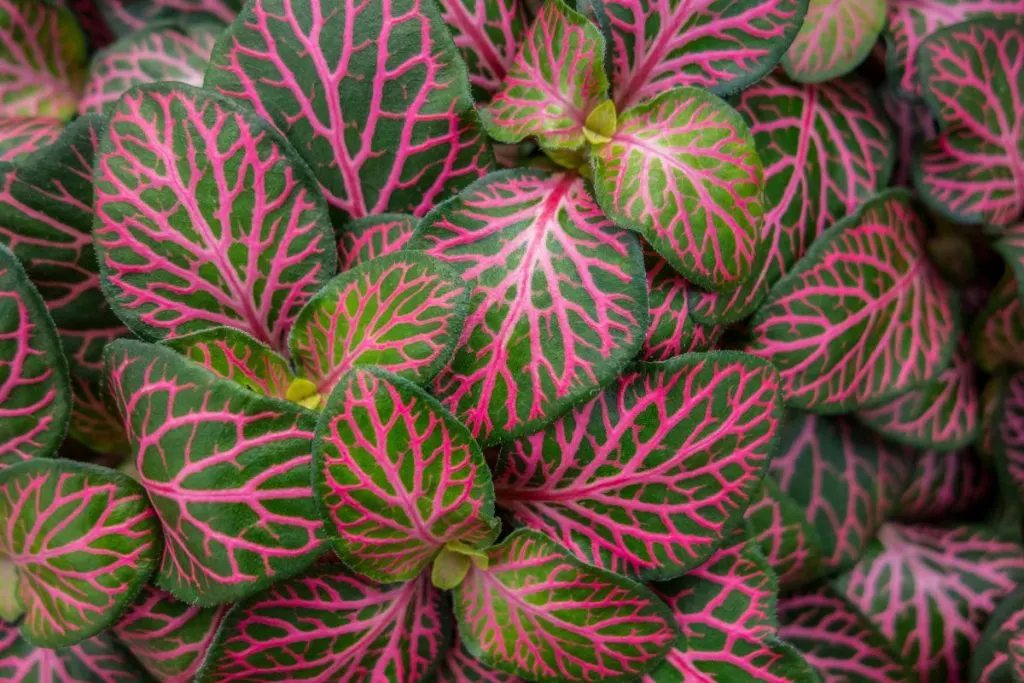
Commonly grown as a houseplant, the nerve plant is an evergreen perennial with slender roots and dark green ovoid leaves. The most popular root color is silvery white, but there are also red, pink, and white.
Light Conditions
A tropical plant that grows naturally in the moist, bright shade of rainforests, it prefers similar conditions when grown as a house flower. It does not like full sun and prefers bright, indirect sun, such as a north-facing window.
Soil Type
Fittonia grows best in standard peat-based potting soil. Prefers slightly acidic soil pH (6.5). The soil should retain some moisture and be well drained.
Water Schedule
Keeping plants moist can be difficult. Nervous plants tend to topple over if allowed to dry out. At the other extreme, water-stagnant Fittonia plants develop yellow and wilted leaves.
Temperature And Humidity
Nervous plants grow best in temperatures around 70F but will tolerate the low 60F range. Many growers believe that this beautiful but capricious plant can easily be grown in a terrarium, bottle garden, or indoor garden that can receive high humidity and diffused light.
Fertilizer
During the growing season, feed the plants weekly with a small amount of liquid tropical plant fertilizer. Use a dilute of a balanced 5-5-5 fertilizer.
Propagation
Neural plants are easily propagated from cuttings taken in late spring or early summer when transplanting plants. Stem cuttings are the best way to propagate nervy plants.
7. African Lillies Plant
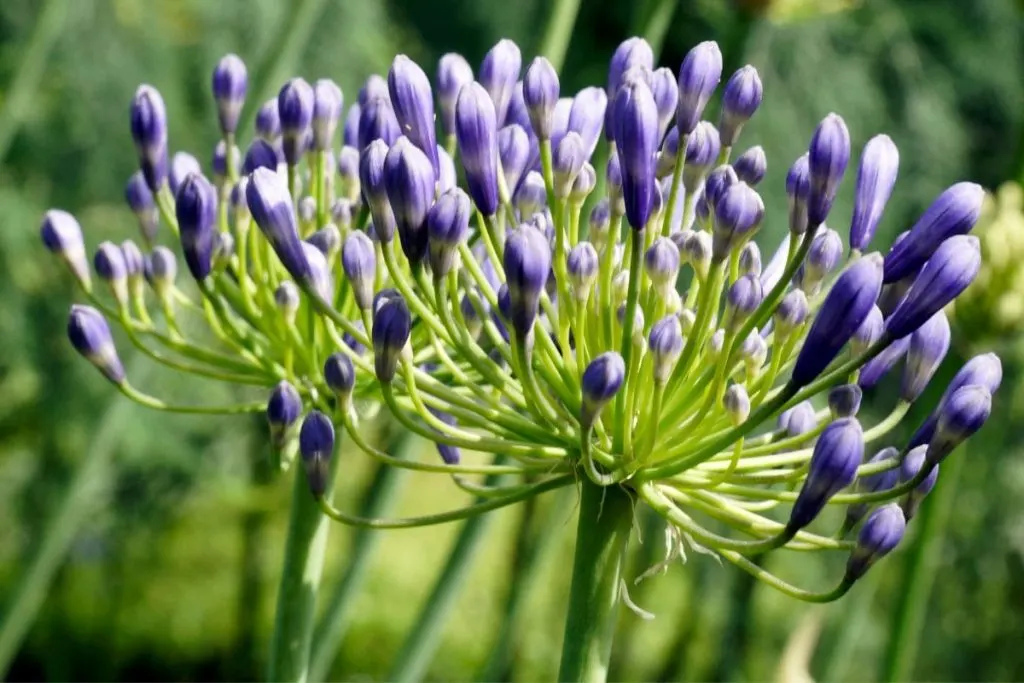
Agapanthus, also known as African blue lily or simply African lily, is a beautiful indoor plant. Mature plants grow in dense bands of leaves, followed by flowering in late spring to late summer. Similar beauties are african mask plant and palm lily.
Light Conditions
They love bright indirect sunlight. Many people even go outside to enjoy the flowers in the summer. A cool, slightly dark room is ideal for winter.
Water Schedule
Start watering regularly in the spring and leave it until it is in full bloom. In winter, when the flower stems wilt and the weather cools, move the plant indoors and allow the water to dry out almost completely while the plant rests.
Soil Type
Rich peat-based soil is best. Mix soil and peat moss work well for this plant too. Good drainage helps.
Fertilizer
From spring until flowering, apply a light liquid fertilizer. Stop feeding during the flowering period and stop feeding in winter. This plant will flower aggressively when slightly stressed.
Propagation
Agapanthus is easily propagated by division. In the spring, dig up a bunch of plants, plant them in new containers, water them well, and put them in a warm place.
8. Silver Vase Plant – Colorful Houseplants
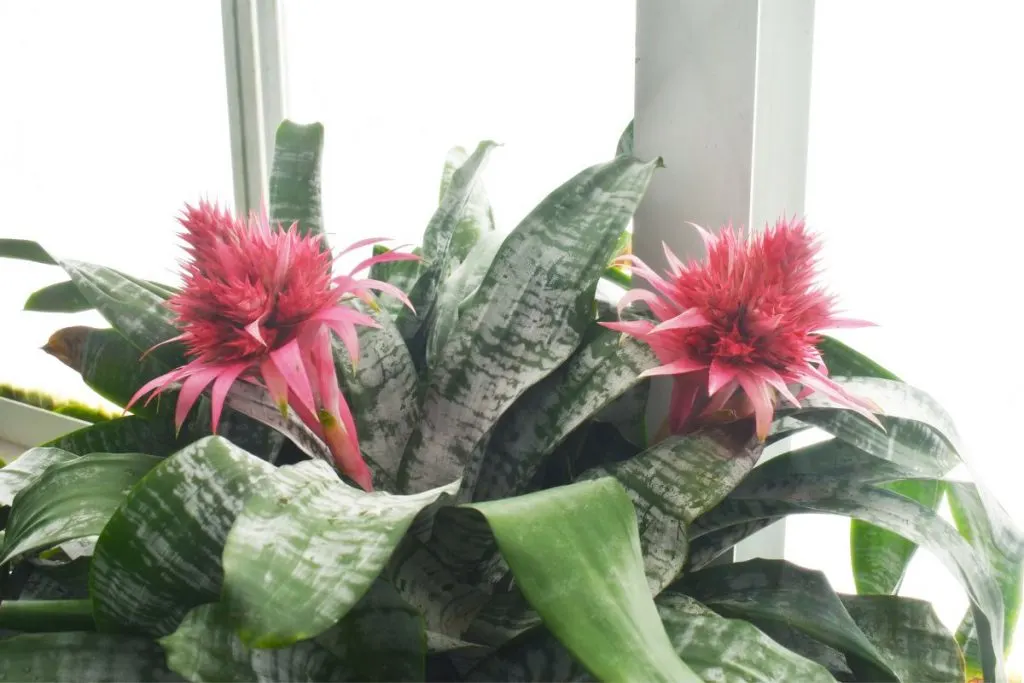
Any flower garden needs a foil to act as a contrasting flower, and the silver vase will stand out as a neutral plant in any color scheme.
Light Conditions
A silver vase needs full sun to keep it compact and retain its beautiful foliage color. Plants that grow in the shade produce less hair and legs that give them a silver color.
Soil Type
Silver vase plants adapt to a variety of soils, but need good drainage for healthy plants. Whether the soil is covered with rock or is characterized as clay, fertilizing the soil with compost can improve pH and drainage.
Water Schedule
The fuzzy growth that gives the silver vase a sheen helps keep plants tall during drought. Like other plants in Mediterranean climates, silver dust requires occasional watering after settling.
Temperature And Humidity
As a Mediterranean plant, the silver vase grows best in warm, sunny climates. Excessive moisture is not a problem as long as the plant has enough space and is sunny.
Fertilizer
Silver vase plants are easy-feeding plants and only require supplemental fertilizer on very poor soils. In this case, it is better to nourish and improve the soil at the same time by adding organic matter such as rotted manure or leaf mold.
Propagation
Silver vases can be propagated by cuttings in the spring when the plants grow the fastest.
9. Good Luck Plant -Ti Plant
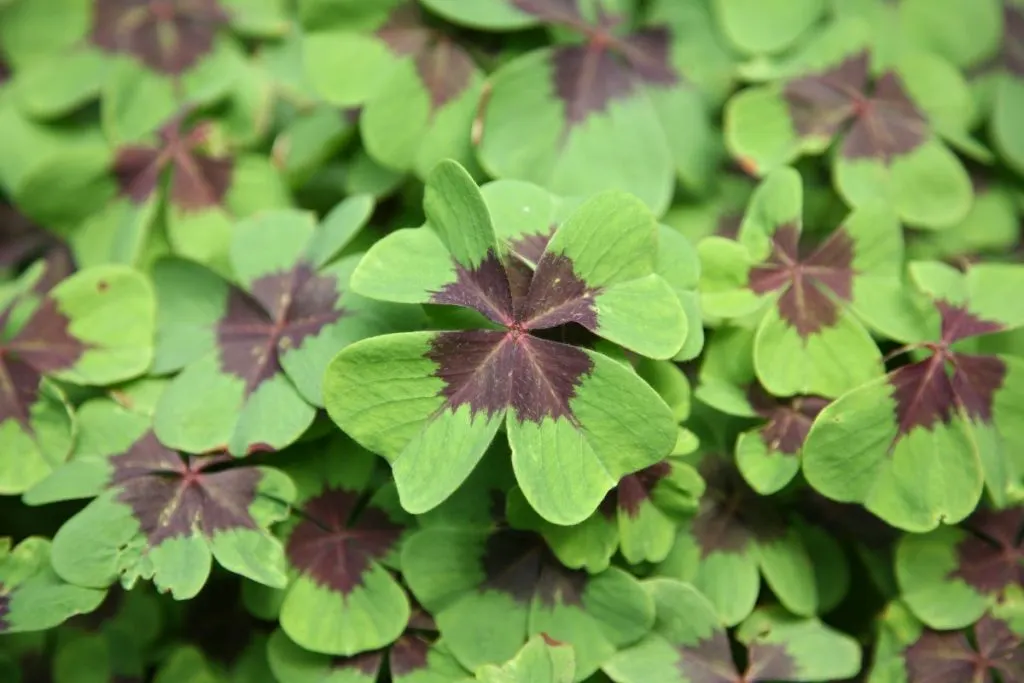
The ti plant (good luck plant) is an evergreen tropical tree with colorful palm-like leaves. It can be grown as a landscape specimen in tropical climates but is most commonly grown as a houseplant. This plant is one of the best plants for office with no windows as well.
Light Conditions
It is a bit difficult to get the exposure right with this plant. This is because sunlight gives leaves the best color, but too much direct sunlight can turn the tips and edges brown.
Soil Type
Ti plants prefer fertile, well-drained, slightly acidic soil. Sand or clay works best when there is a lot of organic matter. Avoid areas with wet or hard clay and salt spray. Roots and stems can rot if you plant them in too wet or shady places.
Water Schedule
As a garden plant, your plants grow best in soil that is kept moist but not constantly saturated. Watering several times a week will see it through the growing season, but it is not uncommon for this plant to receive daily rainfall in its native conditions.
Temperature And Humidity
This plant cannot tolerate long-term temperatures below 50F. Ti plants grow best where the temperature is kept in a constant range between 65 and 95F.
If you are growing indoors with dry winter air, it may be helpful to increase the humidity by placing the pot in shallow water filled with rock.
Fertilizer
When planting outdoors, feed plants once in the spring with a sustained-release fertilizer balanced with nitrogen, phosphorus, and potassium (8-8-8 or 10-10-10).
Propagation
Ti plants can be propagated in a variety of ways, including layering, cuttings in water, division, or seeding. However, one of the easiest ways is to root short stems.
10. Coleus Plants
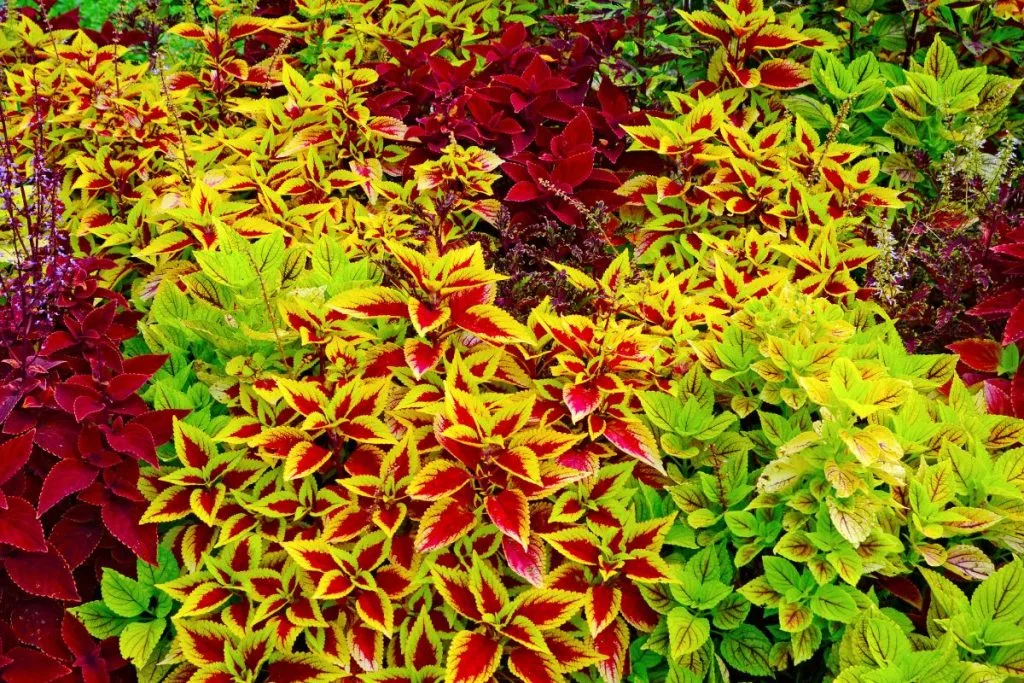
Famous for its flowering plants in the Victorian era, Coleus made a huge profit thanks to the year-round color provided by its beautiful foliage, whether planted in sun or shade.
Light Conditions
Coleus is a classic shade for shading plants, but the lighting effect varies by variety. Older seed coleus does best in full shade to partial shade, while newer varieties like the Wizard series do best in full sun. A similar care guide has an urn plant.
Light Conditions
Coleus prefers consistently moist, rich, and well-drained soil. Treat the soil with compost or other organic matter before planting. Good quality potting soil is suitable for pots. Choose a container with a drain hole.
Water Schedule
Coleus plants grow best in moist but not wet soil. Although the soil is not always wet, a long dry period slows plant growth and causes the edges of the leaves to turn brown.
Temperature And Humidity
As a tropical plant, coleus grows best in warm, humid areas. In mild climates, a faint smell of frost marks the end of the plant. Move plants indoors or shelter them on cold nights when the temperature drops below 50 degrees.
Fertilizer
If the soil is fertile, it is not necessary to feed Coleus plants. If the soil is poor, add a balanced, slow-release fertilizer to the bed. Light fertilizer application will give you the best color from your coleus leaves.
Propagation
Your favorite coleus plant can be easily propagated by the stem and root cuttings. Cut below the leaf nodes along the stem. Remove all leaves from the lower half of the cutting.
11. Flamingo Flower (Flamingo Willow) – Colorful Houseplants
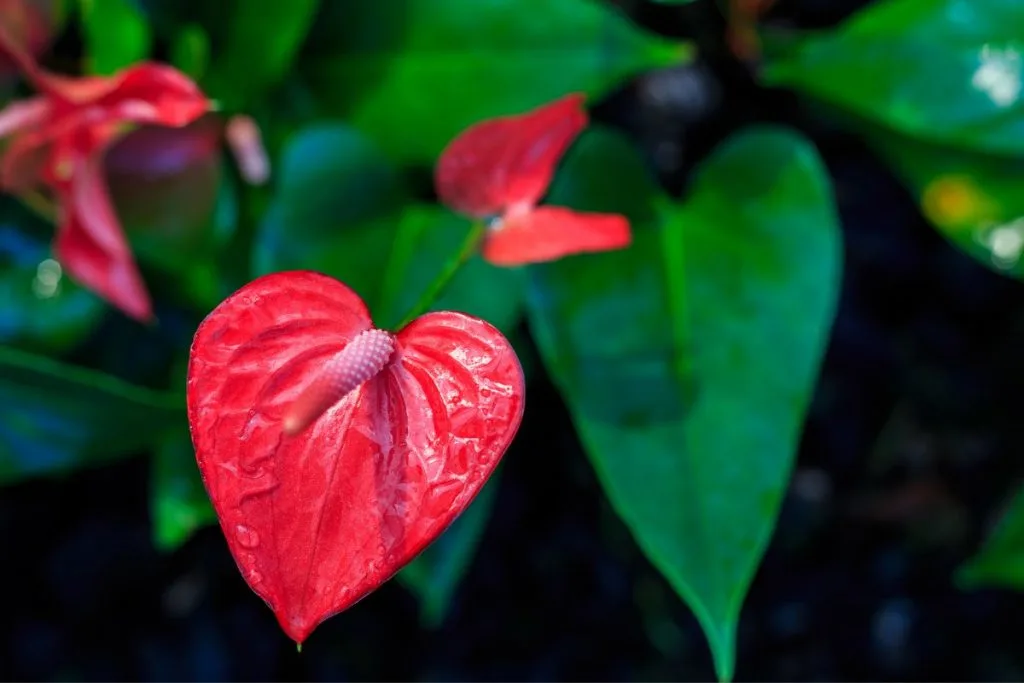
Flamingo willow is a very fast-growing hardwood shrub. This Flamingo offers a beautiful stem and light green leaf colors. The leaves are tricolor: spring, white, green, and light pink. It has amazing colorful foliage. A similar plant is a paradise plant.
Light Conditions
Full sun produces the best foliage color, but the shrub tolerates some shade and prefers shade in very hot climates. Bright indirect light is the best choice.
Soil Type
This plant prefers moist but well-drained soil rich in organic matter. Peat moss works great too.
Water Schedule
The question of how often to water flamingo grass doesn’t apply. Trees can only grow in wetlands where they can get all the water they need. Apply a thick mulch over dry soil to help retain soil moisture.
Temperature And Humidity
The best leaf colors are obtained in cooler climates north of Zone 7. This plant is resistant to a wide range of humidity.
Fertilizer
Willow does not require additional fertilizer. If you provide other conditions for this plant fertilizer won’t be needed.
Propagation
Like all willows, flamingo willows are very easy to propagate. In the spring, cut the leafless conifer stems to 8 inches.
Fill small garden pots with good quality potting soil and insert the cuttings. Willows are ready for transplanting when the root system is visible through the drainage holes.
12. Cabbage Plant (Kale Plant)
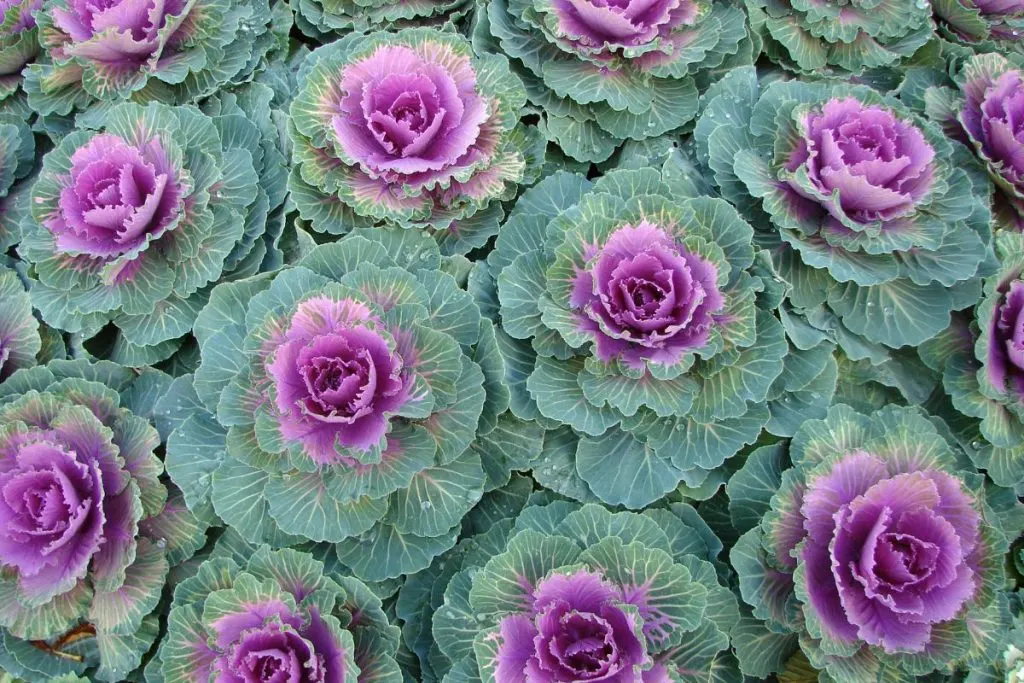
Ornamental cabbages look and grow like their closest relatives, kale and collard greens. Although classified as edible varieties, these ornamental varieties were grown for appearance rather than taste. This plant looks great in hanging baskets along with a similar mosaic plant.
Light Conditions
This plant prefers to grow in sunny places. However, if you are growing in a warm climate, part shade in the afternoon is ideal.
Soil Type
Organically rich, well-drained loamy soils are ideal for these plants. Cabbage and cabbage prefer slightly acidic soils of 5.5 to 6.5.
Water Schedule
The plants must be watered well. They like soil that is consistently moist, but not wet. When the top of the soil is dry, you need to water it. If the climate is regular rains, there is no need for watering. But be prepared to add extra water during dry spells.
Temperature And Humidity
Cabbage and ornamental cabbage do not become fully colored unless well chilled by night frosts. They can survive all winter, but their appearance depends on the weather.
Moisture is usually not a problem for these plants.
However, if the weather is wet and the plants have poor air circulation, fungal diseases can develop.
Fertilizer
Fertilize decorative cabbage and kale with a balanced fertilizer only at planting. Do not fertilize during growth. Otherwise, the color may fade and your legs will be elongated.
Propagation
These biennials are usually removed before the second flowering season and seeded. If you leave the seeds in your garden for planting, you can harvest the seeds from the wilted flower heads and replant them at the right time.
13. Croton Plant
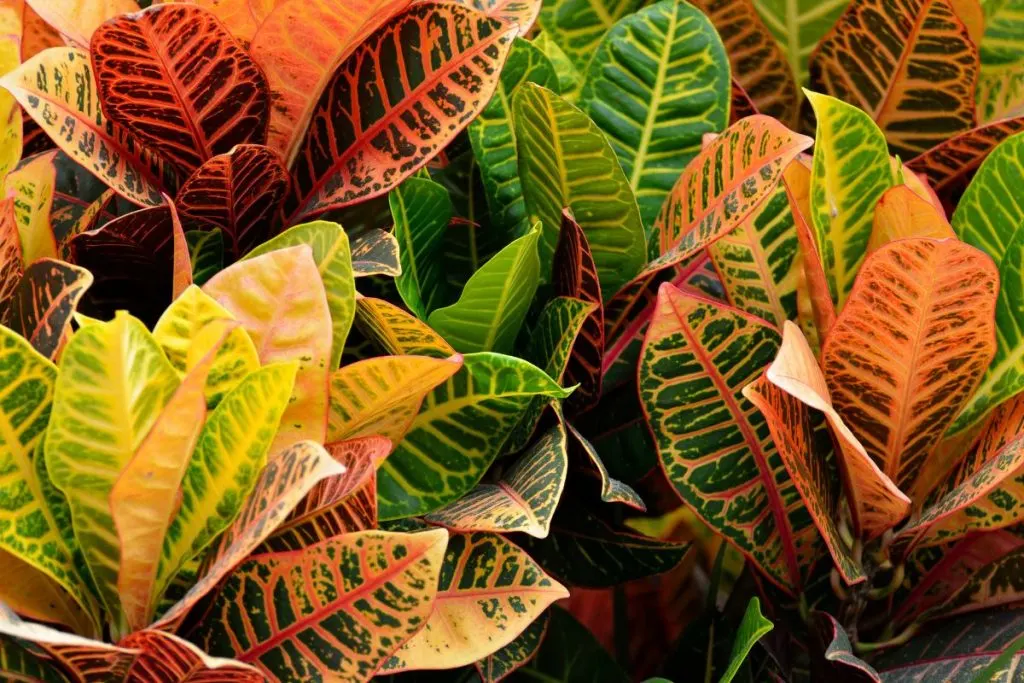
Croton plants have colorful leaves and almost endless leaf shapes. Evergreen in drought-tolerant USDA zones 11 and 12, often grown outdoors as an ornamental shrub.
Light Conditions
Crotons need strong and indirect lighting. Some do not tolerate direct unfiltered sunlight and tend to thrive in dappled sunlight.
When the plant does not have the light it needs, the plant has dark green leaves and then entire green foliage with no colors. The direct sun however can kill it.
Water Schedule
In summer, keep it evenly moist. Croton plants need about an inch of water per week. In winter, reduce watering for two weeks. Monitor the plant for signs that it needs more water, such as wilting young leaves.
Soil Type
Moist soil with good drainage and rich compost is ideal. This plant likes acidic soils rich in humus.
Temperature And Humidity
Keep the room above 60 F and avoid exposing the plants to cold winds. Along with the lack of bright light, humidity also affects the color of the leaves. Keep humidity at 40-80%. Insufficient moisture can cause the plant to drop some leaves.
Fertilizer
During the growing season of early spring, mid-summer, and early fall, the sustained release granules are applied three times. Alternatively, apply a liquid fertilizer monthly during the growing season from early March to late September.
Propagation
Croton plants can be propagated at any time of the year. The dependent factor is temperature. In tropical areas where temperatures are maintained in the 70-80F range, croton plants can be grown outdoors year-round.
FAQ – Colorful Houseplants

In case you want to learn more about these stunning purple and bright green plants, we bring this section below.
Find more about a colorful tropical houseplant and its shiny green leaves and pink flowers. Pink leaves are more than wonderful, but will they stay like that all year long?
What’s The Most Colorful Houseplant?
Croton tops the list of colorful houseplants because of its colorful leaves beautifully bordered with spots and stripes. Fortunately, croton plants grow indoors in partial sun and can make bold statements at home.
Croton is an excellent indoor breed as it can tolerate low light conditions. Depending on the lighting, it can look from dark red to deep purple. Croton is considered an ornamental plant.
Do Colorful Plants Keep Their Color All Year Long?
Some colorful houseplants won’t keep their color all year long. However, if you’re lucky enough to have some of these plants then you’ll get to keep their color for 365 days.
Those plants are croton, coleus, ninebark, aluminum plant, nerve plants, begonia plants, smoke trees, and others. Their dramatic foliage will stay colorful all year long with no other extra effort. Attractive foliage will be bright red and bright pink all year long on these indoor plants.
What Plant Has Colorful Leaves?
What Are The Best Colorful Plants For Hanging Baskets?
These colorful plants are the best indoor plants for a hanging basket:
- Rick Rock Cactus
- African mask plant
- Hoya Carnosa
- Hoyarov plant
- A string of pearls
- Burro tail succulents
- Heartblade Philodendron
In case you don’t have much sun in your home, you can always get colorful hanging basket plants for shade.
Is There A Blue Houseplant?
Common blue houseplants include creeping blue sedum, brilliant agave blue flame, blue hosta, silver sword philodendron, and “bluebird” plants crassula ovata. Some of these plants have a bluish tint on their leaves and stems. The blue ginger plant is another amazing blue plant.
Wrapping It Up

We have come to the end of another article about plants. I hope you enjoyed it and learned a lot about colorful houseplants. In the end, I also hope that you have decided on one that you like the most.
I know that I am and I’m going to buy it tomorrow. It was a difficult choice, but the pink shades won this time. How do you feel about the red leaves plant? I love them!
In addition to these plants that we have presented to you, several other plants can complement your home with colors.
They are birds of paradise, gerbera daisy, orchids, shell ginger, the crown of thorns, and rex begonia. If you like some of these plants better, you won’t go wrong!

